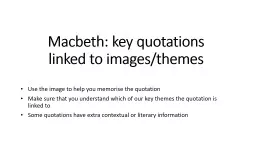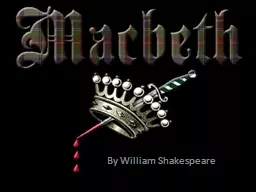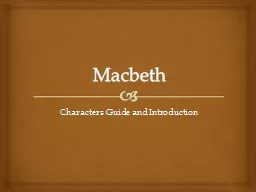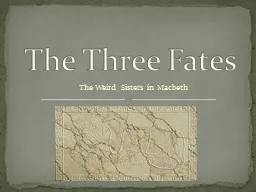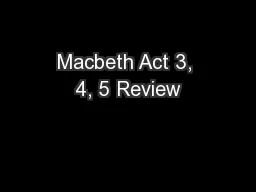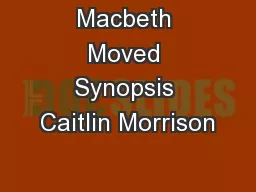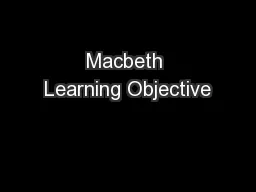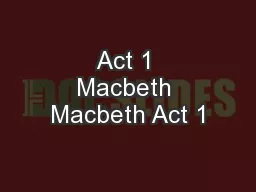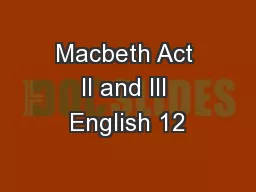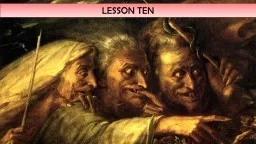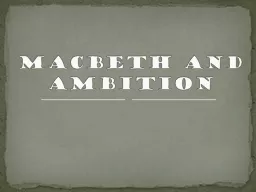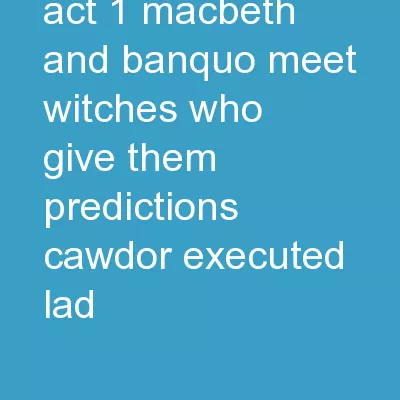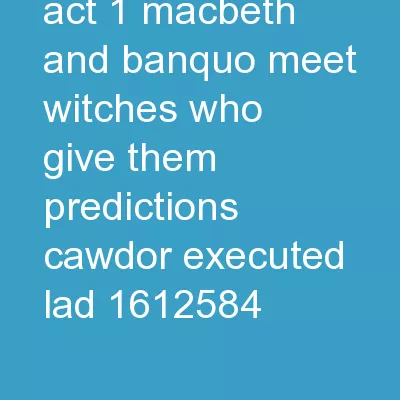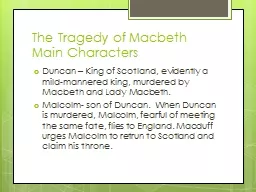PPT-Macbeth: key quotations linked to images/themes
Author : sherrill-nordquist | Published Date : 2018-09-25
Use the image to help you memorise the quotation Make sure that you understand which of our key themes the quotation is linked to Some quotations have extra contextual
Presentation Embed Code
Download Presentation
Download Presentation The PPT/PDF document "Macbeth: key quotations linked to images..." is the property of its rightful owner. Permission is granted to download and print the materials on this website for personal, non-commercial use only, and to display it on your personal computer provided you do not modify the materials and that you retain all copyright notices contained in the materials. By downloading content from our website, you accept the terms of this agreement.
Macbeth: key quotations linked to images/themes: Transcript
Use the image to help you memorise the quotation Make sure that you understand which of our key themes the quotation is linked to Some quotations have extra contextual or literary information Key themes. By William Shakespeare. Act I. Duncan—King of Scotland. Malcom. —Son of Duncan; prince of Cumberland. Donalbain. —Son of Duncan (quiet so far). Banquo. —Macbeth’s best friend/with him during the prophecies.. By William Shakespeare. Meet the dramatis personae. The Three Weird Sisters. http://theplaymaker.wordpress.com/2008/05/. schoolworkhelper.net. Meet the dramatis personae:. Lady Macbeth and Macbeth. prestonopera.org.uk. Characters Guide and Introduction. Take your paper and fold it long ways.. Take the folded paper and on the outside make 16 sections.. Make the same sections on the inner fold just beneath. . You will flip up the name of the character and see the important characteristics beneath. . The Three Fates. Greek Mythology. Known as the “. Moirai. ”. They decide the individual fates of the ancient Greeks. Clotho. – “the spinner”. Lachesis. – “drawer of lots”. Atropos. – “inevitable”. Will the winners lose? Rules. I will ask a question.. Whoever writes their answer first and raises their board first wins.. I will check if it’s right. If not, they are disqualified from that question and the remaining groups can have a chance to answer.. 2012. Begin Act 1.. Our play begins near a battlefield. Three witches enter and help set the spooky mood of the play. Then, they notice someone coming. They say:. Witches:. “Fair is foul, and foul is fair. Read and understand Act 1 Scene 5 and 6.. Begin to understand the character of Lady Macbeth.. Starter. Complete an A – Z of ‘Macbeth’ so far.. Act 1 Scene 5. Read the opening of Act 1 Scene 5 carefully. Afterwards we will be thinking about and discussing the following:. Scene 1. Characters: . The Weird Sisters. Themes: . Fate . Nature . and the Unnatural . Character’s Introduced. Themes PRESENT. Paradox:. a statement whose two parts seem contradictory yet make sense with more . Warm Up. Motif-. a. . recurring. subject, theme, idea, etc., especially in a . literary,. . artistic,. . or. . musical. . work.. . Name some motifs we have seen in Macbeth.. Act I Recap. Witches planning evil involving Macbeth. YOUR TASK: ACT 3, SCENE 5. TODAY’S KEY QUESTIONS:. Can I read, understand and respond to texts?. Can I . consider the social and historical context of ‘Macbeth’ and discuss its significance?. Can I analyse the language in a scene and explain its significance?. Sparks his ambition. LM is using her husbands desires to achieve her own ambition as well.. Macduff and Malcolm care more about Scotland than their desires... Macbeth. : Ambitious, brutal, but seemingly loyal . Act 2. Macbeth sees a dagger reflecting his doubts about the murder- but kills Duncan with Lady Macbeth’s help. Malcolm flees and Macbeth chosen to be king.. Act 3 . Banquo suspects Macbeth – Macbeth murders Banquo but his son . Act 2. Macbeth sees a dagger reflecting his doubts about the murder- but kills Duncan with Lady Macbeth’s help. Malcolm flees and Macbeth chosen to be king.. Act 3 . Banquo suspects Macbeth – Macbeth murders Banquo but his son . Duncan – King of Scotland, evidently a mild-mannered king, murdered by Macbeth and Lady Macbeth.. Malcolm- son of Duncan. When Duncan is murdered, Malcolm, fearful of meeting the same fate, flies to England. .
Download Document
Here is the link to download the presentation.
"Macbeth: key quotations linked to images/themes"The content belongs to its owner. You may download and print it for personal use, without modification, and keep all copyright notices. By downloading, you agree to these terms.
Related Documents

